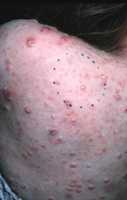Transmission

Typical molluscum bumps. Note the pearly appearance and the dimple in the center of the bumps. Image courtesy L. Sperling, MD, Walter Reed Army Medical Center.

Severe case of molluscum on an immunocompromised patient's back. Image courtesy Inger Damon, MD, CDC.
The virus that causes molluscum spreads from direct person-to-person physical contact and through contaminated fomites. Fomites are inanimate objects that can become contaminated with virus; in the instance of molluscum contagiosum this can include linens such as clothing and towels, bathing sponges, pool equipment, and toys. Although the virus might be spread by sharing swimming pools, baths, saunas, or other wet and warm environments, this has not been proven. Researchers who have investigated this idea think it is more likely the virus is spread by sharing towels and other items around a pool or sauna than through water.
Someone with molluscum can spread it to other parts of their body by touching or scratching a lesion and then touching their body somewhere else. This is called autoinoculation. Shaving and electrolysis can also spread mollusca to other parts of the body.
Molluscum can spread from one person to another by sexual contact. Many, but not all, cases of molluscum in adults are caused by sexual contact.
Conflicting reports make it unclear whether the disease may be spread by simple contact with seemingly intact lesions or if the breaking of a lesion and the subsequent transferring of core material is necessary to spread the virus.
The molluscum contagiosum virus remains in the top layer of skin (epidermis) and does not circulate throughout the body; therefore, it cannot spread through coughing or sneezing.
Since the virus lives only in the top layer of skin, once the lesions are gone the virus is gone and you cannot spread it to others. Molluscum contagiosum is not like herpes viruses, which can remain dormant ("sleeping") in your body for long periods and then reappear.
- Page last reviewed: May 11, 2015
- Page last updated: May 11, 2015
- Content Source:


 ShareCompartir
ShareCompartir